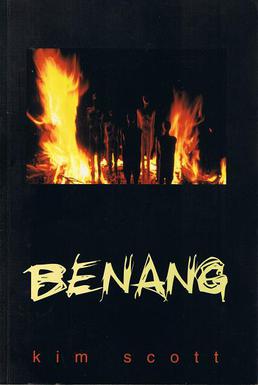Benang: From the Heart facts for kids

First edition cover
|
|
| Author | Kim Scott |
|---|---|
| Country | Australia |
| Language | English |
| Genre | Novel |
| Publisher | Fremantle Press, Australia |
|
Publication date
|
1999 |
| Media type | Print (Paperback) |
| Pages | 497 pp |
| ISBN | 978-1-86368-240-4 |
| OCLC | 41877548 |
| 823/.914 21 | |
| LC Class | PR9619.3.S373 B46 1999 |
Benang: From the Heart is a novel written by Australian author Kim Scott. It won the Miles Franklin Award in 1999, sharing the prize with Drylands by Thea Astley. The book explores important themes about identity, family, and history, especially for Indigenous Australians.
Contents
Understanding the Novel's Background
The novel talks about a sad part of Australian history. This was a time when many Aboriginal children were taken from their families. They were then forced to live in white Australian society. This was part of a policy that aimed to make these children lose their Aboriginal identity. It was wrongly believed that over time, there would be no visible trace of Aboriginal heritage left.
A key person in this policy was A. O. Neville. He was the Chief Protector of Aborigines in Western Australia. He thought this process would work. This policy happened because the government struggled to classify children of mixed heritage. They also had fears about what mixing cultures might mean for society.
Australia was first claimed to be uninhabited by Europeans. The children who were forcibly removed from their homes are known as the Stolen Generations. These were children of both Aboriginal and white Australian heritage. Many people believe that this forced removal and cultural loss was a form of cultural destruction.
What the Story is About
Benang is a story about forced cultural assimilation. This means making people give up their own culture and adopt another. The book shows how hard it is to create a clear history for people who were cut off from their past.
The novel follows a young man named Harley. He has been affected by the policies that aimed to remove Aboriginal identity. Harley tries to put together his family history. He uses old documents like photographs and his grandfather's notes. He also uses memories and experiences to understand his past. Harley and his family went through a process that separated them from their Indigenous Australian families and origins.
Main Characters
- Ernest Soloman Scat – Harley's grandfather and a scientist. He focused on experiments to remove Aboriginal identity.
- Harley Scat – The main character of the novel.
- Auber Neville – Ernest's cousin.
- Kathleen Chatalong – Jack's sister.
- Harriette Coolman – Harley's great-grandmother on his mother's side.
- Daniel Coolman – Harley's great-grandfather on his mother's side. He was an Irishman and cousin to the Chatalongs.
- Will Coolman – Daniel's son.
- Patrick Coolman – Daniel's twin brother.
- Jack Chatalong – Kathleen's brother.
- Constable (Sergeant) Hall – A father figure to Kathleen.
- Sandy One Mason – Harley's white great-great-grandfather.
- Fanny – Harley's Nyoongar great-great-grandmother.
Important Ideas and Themes
The novel explores deep questions about identity and belonging. Harley often wonders who he truly is. He feels like he is a mix of different worlds.
- The book shows how difficult it is to understand your heritage when parts of it have been hidden. Harley searches for his family's past. He finds that many records and memories were lost or changed.
- A key theme is the idea of being "diluted" or "bred out." This refers to the historical policy of trying to make Aboriginal people lose their identity. The book questions what it means to be "white" or "Aboriginal."
- The novel also highlights the strength and survival of the Nyoongar people. Despite the challenges, their culture and spirit remain.
- Ultimately, Benang is a powerful story about finding your true self. It shows the importance of connecting with your ancestors and understanding your history. Even when it is painful, knowing your past helps you know who you are.
What People Thought of the Book
K. Kunhikrishnan reviewed Benang for The Hindu. He wrote that Kim Scott spent five years researching for the novel. Scott traced his own family history through old welfare files and other sources. The author confirmed that his research inspired the book.
The novel mixes real facts with made-up stories. It uses historical documents to explore the sad history of how white people treated Aboriginal Australians. It does this without being preachy or bitter. The book is a moving picture of how cultures can be oppressed. It also shows the amazing strength of the Nyoongar people since they first met European settlers.
The way the story is told in Benang can be complex. It uses a style similar to stream of consciousness. This means it mixes facts, history, and memories together. This style can be confusing at first. However, as you keep reading, all the memories, thoughts, and feelings come together. This helps you understand the narrator's journey.
Awards Received
- The Kate Challis RAKA Award, Creative Prose, 2001: winner
- Miles Franklin Literary Award, 2000: joint winner
- Western Australian Premier's Book Awards, Fiction Award, 1999: winner
See Also
- Cultural genocide
- Declaration on the Rights of Indigenous Peoples
- Genocide
- History of Australia
- History wars
- Moseley Royal Commission
- Our Generation (film)
- Stolen Generations
- White Australia policy
- White Stolen Generations

